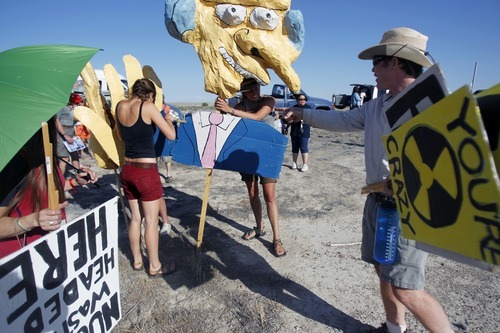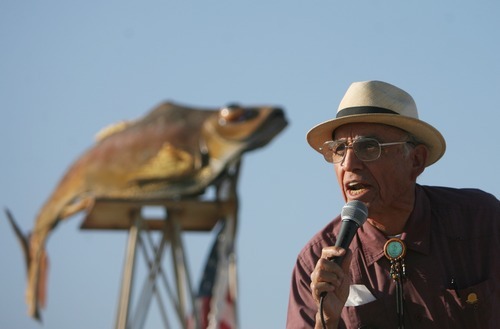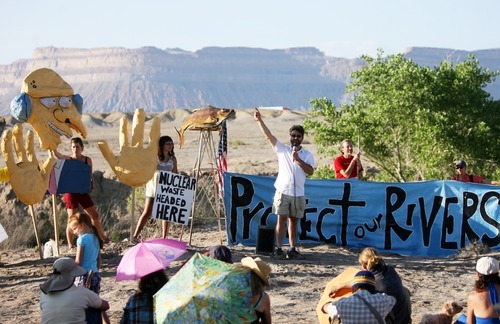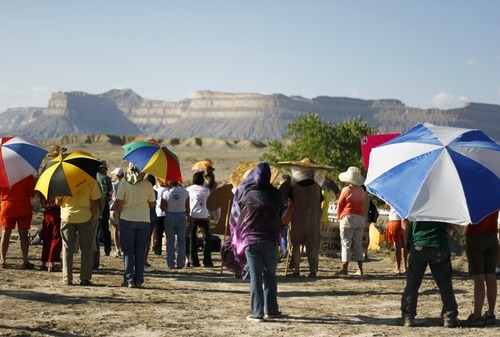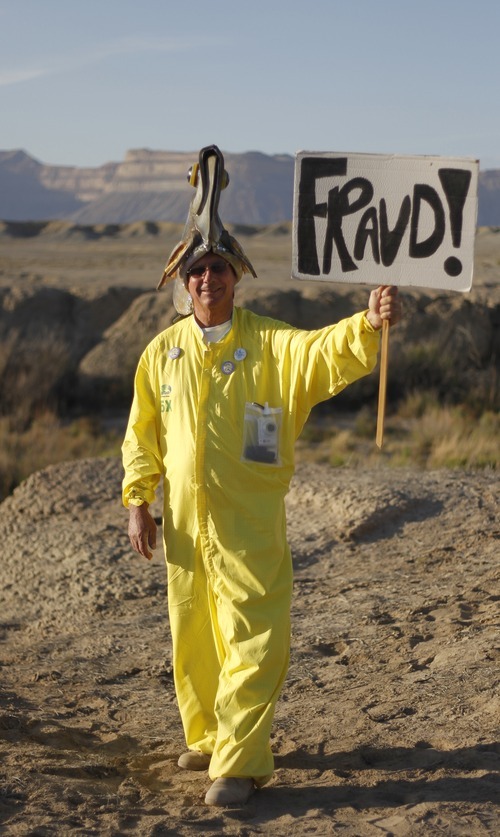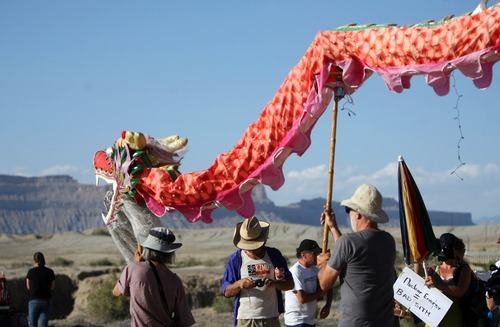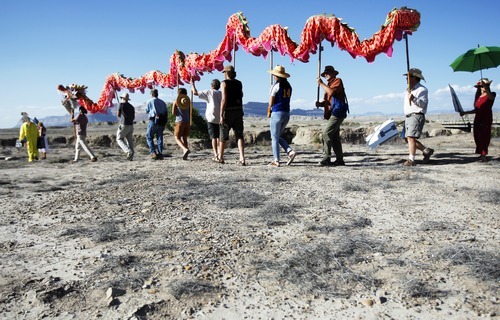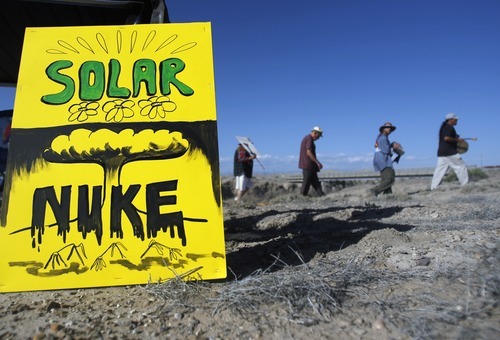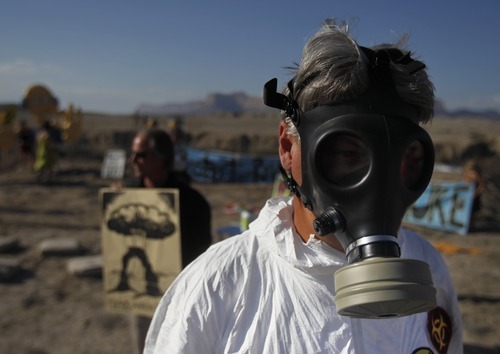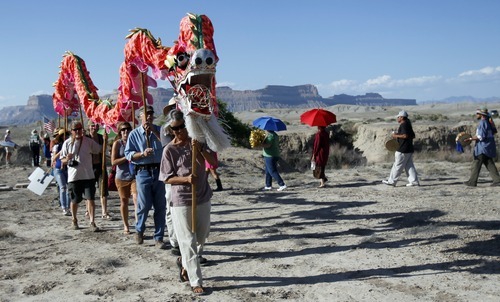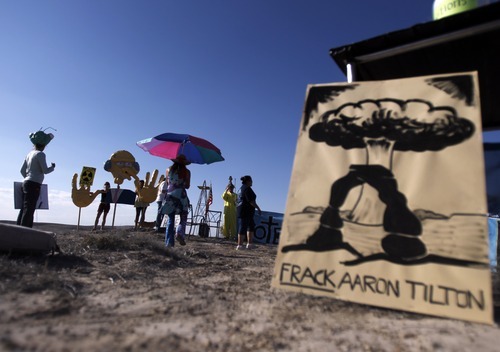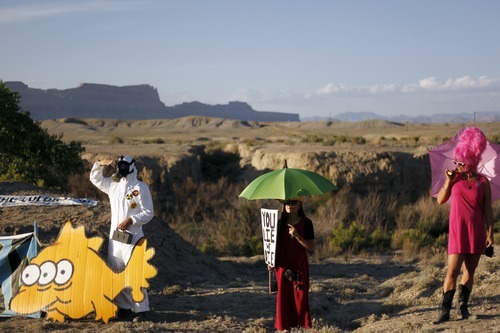This is an archived article that was published on sltrib.com in 2012, and information in the article may be outdated. It is provided only for personal research purposes and may not be reprinted.
Green River • More than 100 demonstrators gathered on the sun-baked desert just south of a proposed nuclear power plant here Saturday evening, protesting both the envisioned reactors and the big gulp of disputed river water needed to cool them.
A "No Green River Nuke Coalition" that included Uranium Watch, HEAL Utah, Living Rivers and residents of southeastern Utah chanted along with an American Indian blessing of the land, and some donned costumes including mushroom clouds and foam fish heads honoring endangered species of the Green and Colorado rivers.
"This [nuclear plant] is never going to be," elder Moab river runner and inn owner Ken Sleight told the crowd over a public-address system, "but by hell we're going to have to fight for it."
"We're not going to have this beautiful area polluted with radioactivity or waste," he said, "and we're not going to let them take that water out of this river."
The water, upward of 50,000 acre-feet per year, or enough to supply a moderately sized Utah city, is the subject of a lawsuit that these groups and some Moab river guides have filed. Their aim is to reverse the state engineer's approval of a withdrawal of water that they say the river — either for fish or for recreation — can't afford.
Uranium Watch program director Sarah Fields, of Moab, said she believes the nuclear promoters are speculating, without the means to build a plant, and may end up leasing the water for other energy projects in eastern Utah.
"I don't think the outfit has the financial wherewithal and the knowledge and experience to carry this out," she said.
Members of California's Fort Mojave Indian Tribe traveled here to inspire protesters with their tale of beating a proposed low-level radioactive waste dump near their revered Colorado River in the 1990s. The Green feeds the Colorado, and they said they oppose the plant here because of potential river degradation.
"Get ready," tribal protester Ron Van Fleet told the demonstrators, "because you're going to have to camp out here. How dedicated are you, when the bulldozers come?"
Fort Mojave members were among hundreds who camped out for 113 days to block federal tests for a potential dump near their homeland, ultimately causing federal officials to back off. Bradley Angel, a part-time Moab resident who directs the California-based Green Action for Health & Environmental Justice, worked with the tribe on that campaign and invited them here for this one.
Their involvement will attract more plant opponents, Angel said.
"They really take their river seriously," he said. "You're going to see tribal power come into this."
The project's proponents, Blue Castle Holdings, have said their core sampling of rock at their chosen site just north of Interstate 70 and south of the Book Cliffs suggests a geologically stable site for the plant. It's also in a power transmission corridor that could be expanded. The water would be piped from the river for cooling, then evaporated and not returned to the flow.
If construction gets under way as planned in 2016, the plant could be generating nuclear power by 2020.
But Blue Castle still faces significant challenges, such as completing a two-step U.S. Nuclear Regulatory Commission licensing process expected to cost $100 million.
Emery County economic development officials have backed the plant, offering industrial land outside this town of numerous abandoned motels, gas stations and other businesses that thrived during a missile-control mission that ended a generation ago.
Three men who were loading a water tank onto a pickup in town on Saturday epitomized what they called a split public opinion among locals.
"I'll move if it gets built," said Austin Carter, who noted that his family homesteaded here generations ago. He would be nervous about radioactive accidents and winter clouds that he believes the cooling steam would generate.
"I'd just like it because it would probably bring more women to town," Theodore Siaperas said. The town has suffered and needs jobs, he said, as evidenced by the failure of a tavern that his brother used to own. "Not enough people drink here."
The third, an older man named Howard Burnett, said he's lived here long enough to see uranium and missile booms and busts come, and this would just be one more.
"I've seen the economy come and go 15 times," he said. "It helps us somewhat."
Moab resident Celia Alario said she attended the protest because she believes the region is at a turning point when it comes to energy. It can either embrace old ways like nuclear or fossil fuels, she said, or use renewables like solar and wind. She favors small-scale renewables for use by locals here, and said Los Angeles and Las Vegas should try the same — installing solar panels on their buildings and parking structures instead of seeking nuclear power from Utah.
"It's time to choose," she said. "It's time to act."



